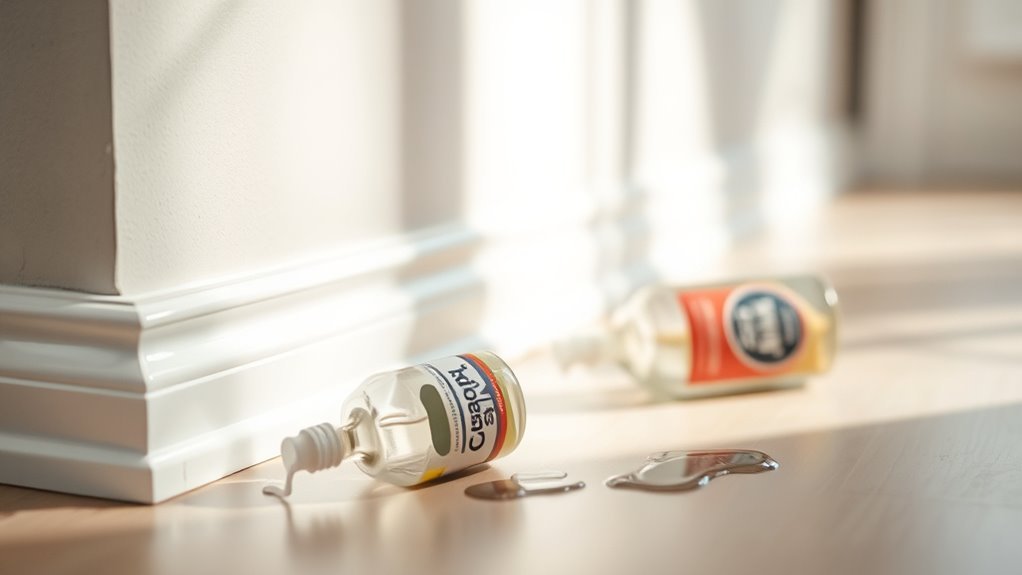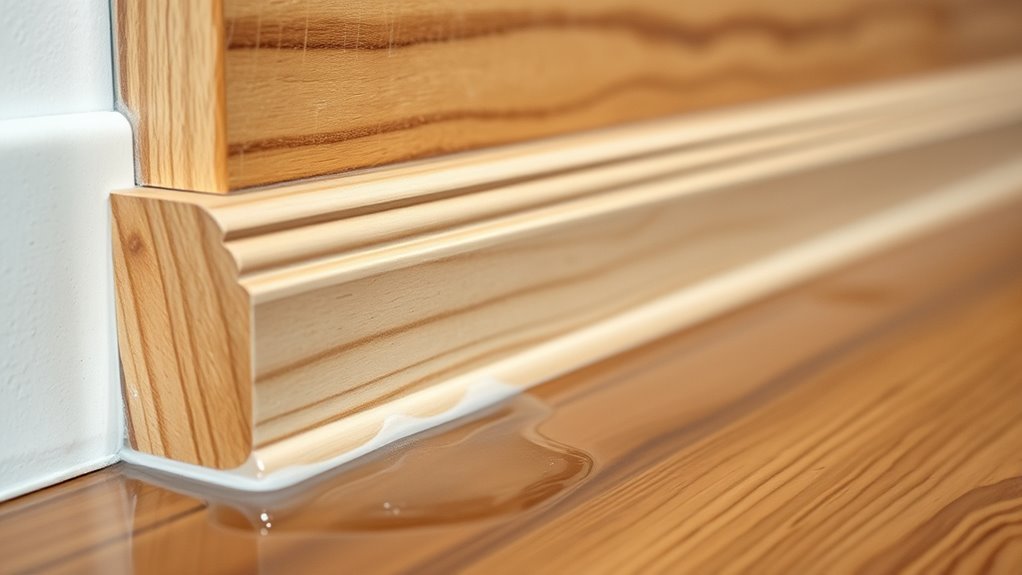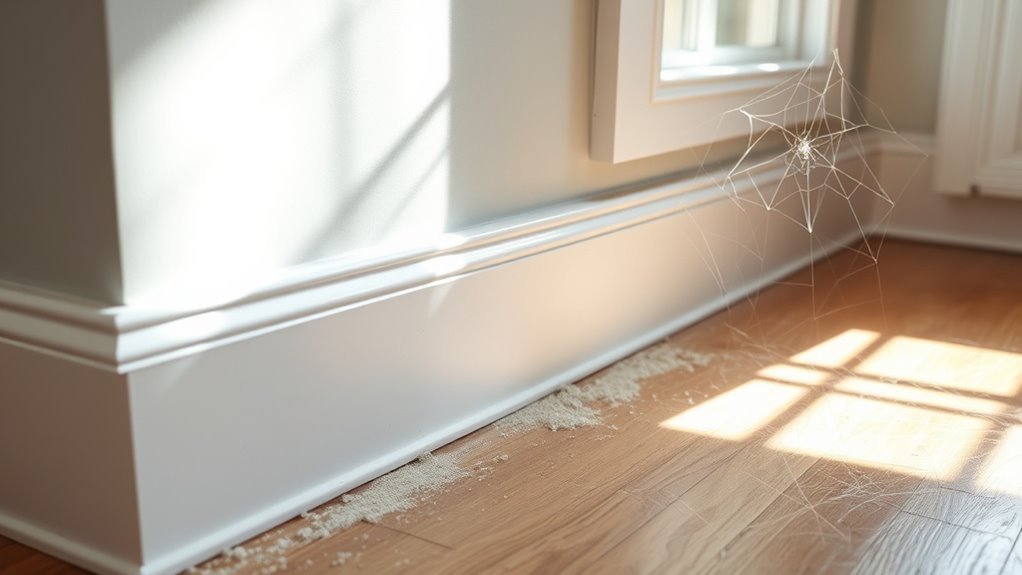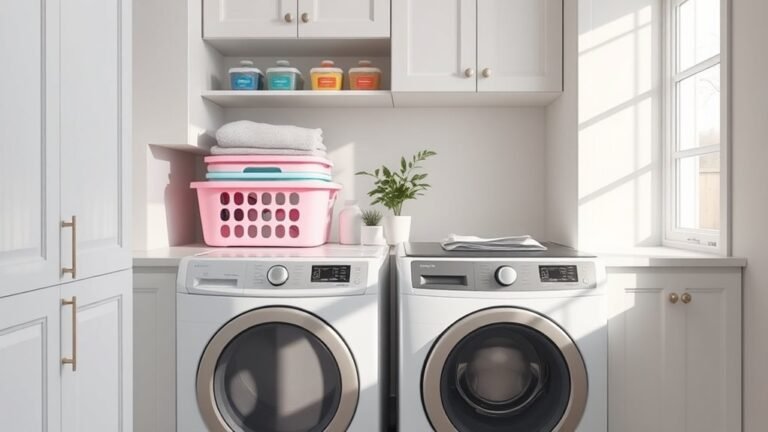Mistakes to Avoid When Cleaning Your Baseboards
When cleaning your baseboards, don’t skip dusting first, or dirt will smear and stick. Avoid harsh chemicals—they can damage paint and cause peeling. Scrubbing too hard risks scratches, so use gentle motions with soft cloths. Also, don’t soak baseboards with water; dampen your cloth instead and dry promptly to prevent warping. Be sure not to miss corners and crevices or ignore regular upkeep. Keep these tips in mind, and you’ll get a better handle on proper baseboard care.
Using Harsh Chemicals That Damage Paint

Although it might seem easier to grab a strong cleaner, using harsh chemicals can quickly ruin your baseboard paint. When you apply aggressive substances, chemical reactions may occur that break down the paint’s protective layer, compromising its integrity. This not only dulls the finish but can lead to chipping and peeling over time. You want your baseboards to look fresh and vibrant, not damaged or worn out. Instead, opt for gentle, eco-friendly cleaners that preserve the paint’s durability while still removing dirt. By avoiding harsh chemicals, you maintain your freedom to enjoy a clean, beautiful space without worrying about costly repainting or repairs. Protecting your paint’s integrity means fewer headaches and more time doing what you love.
Neglecting to Dust Before Cleaning
You might be tempted to skip dusting before cleaning your baseboards, but that’s a big mistake. Removing dust first prevents smearing and makes your cleaning more effective. Using the right tools, like a microfiber cloth or a soft brush, can make this step quick and thorough.
Importance of Dust Removal
Before you start scrubbing your baseboards, it’s essential to remove dust and dirt first. Dust accumulation not only makes your cleaning less effective but can also lead to health implications like allergies and respiratory issues. If you skip this step, you’re just pushing dust around instead of eliminating it, which defeats your purpose. Taking the time to dust properly frees you from dealing with persistent grime and protects your indoor air quality. By removing dust before applying any cleaner, you guarantee a deeper, more thorough clean and avoid spreading allergens throughout your space. Remember, a clean environment supports your freedom to enjoy your home comfortably and confidently without worrying about hidden dirt or health risks.
Common Dusting Mistakes
When you skip dusting before cleaning your baseboards, you’re setting yourself up for frustration and extra work. Dust and dirt can smudge and spread, making your cleaning less effective. To avoid this, adopt simple dusting techniques that loosen and capture dust first. Without this step, you risk pushing dirt into corners or smearing it across surfaces, which wastes time and effort. Using effective tools suited for dusting lets you quickly remove buildup before wet cleaning, making the entire process smoother. Remember, dusting isn’t just a preliminary chore; it’s essential for a thorough baseboard refresh. So, take that extra moment to dust properly—your cleaning freedom depends on it.
Tools for Effective Dusting
Skipping proper dusting often leads to more mess and extra work during baseboard cleaning. To keep your baseboards spotless without hassle, you need the right tools. Don’t just grab any rag; choose based on effectiveness and ease. Here are three must-have tools for effective dusting:
- Microfiber cloths – They trap dust instead of spreading it around, making your job quicker and cleaner.
- Extendable dusters – Perfect for reaching tight corners and high spots without bending or stretching.
- Electrostatic dusters – These attract dust like a magnet, reducing airborne particles and keeping surfaces cleaner longer.
Using the right duster types empowers you to clean efficiently, saving time and energy. Don’t skip this step—proper dusting is freedom from extra mess and frustration.
Scrubbing Too Vigorously and Causing Scratches
Although it might seem like scrubbing harder will get your baseboards cleaner, it can actually cause scratches that damage their finish. You want your baseboards to look fresh without sacrificing their surface protection. Instead of aggressive scrubbing techniques, opt for gentle motions using a soft cloth or sponge. This approach removes dirt effectively while preserving the integrity of the paint or wood. Remember, freedom in cleaning means choosing methods that keep your space looking great longer. If you’re unsure, test your scrubbing technique on a small, hidden area first. Avoid abrasive tools or harsh scrubbing pads that can leave permanent marks. Taking care with your cleaning routine guarantees your baseboards stay smooth and beautiful, letting you enjoy a polished home without unnecessary damage.
Using Excess Water That Leads to Warping

If you use too much water while cleaning, your baseboards can quickly warp or swell. Excess moisture seeps into the wood, causing water damage that’s often irreversible. To keep your baseboards looking great without risking damage, focus on moisture control with these tips:
- Use a damp, not soaking wet, cloth or sponge to wipe down surfaces.
- Immediately dry the baseboards with a clean, dry towel to remove residual moisture.
- Avoid pouring water directly onto the baseboards; instead, apply it to your cleaning cloth.
Ignoring Corners and Crevices
Why do many people overlook corners and crevices when cleaning baseboards? It’s often because these spots seem small or hard to reach, but ignoring them means dirt and dust build up, ruining the clean look you want. If you’re aiming for true freedom from grime, don’t skip corner cleaning. Those tight spaces collect stubborn dust that regular wipes can’t remove. Use a small brush or a vacuum attachment for efficient crevice dusting—it’s quick and gets into nooks where dirt hides. Paying attention to these details guarantees your baseboards look fresh and your home feels truly clean. Don’t let hidden dirt hold you back from enjoying a spotless space; embrace thorough corner cleaning and crevice dusting for a freer, cleaner environment.
Skipping Protective Gloves and Skin Care

Cleaning those hard-to-reach corners is important, but don’t forget about protecting your hands while you work. Skipping protective gloves and proper skin care can lead to irritation or dryness from cleaning agents. To keep your skin safe and comfortable, choose the right glove materials and follow these steps:
- Pick gloves made from nitrile or latex for effective barrier protection and flexibility.
- Avoid cotton gloves alone, as they don’t shield against chemicals and can absorb moisture.
- After cleaning, wash your hands thoroughly and apply a moisturizing lotion to maintain skin protection.
Applying Cleaning Products Directly to Baseboards
When you apply cleaning products directly to baseboards, you risk damaging the paint or causing streaks that are hard to remove. To keep your space looking fresh without the hassle, focus on smart cleaning techniques. Instead of spraying or pouring cleaners straight onto the baseboards, apply them to a cloth or sponge first. This lets you control the amount and prevents oversaturation. Your product selection matters too—choose gentle, non-abrasive cleaners that suit your baseboard material. Harsh chemicals might seem effective but can lead to peeling or discoloration. By combining thoughtful product selection with careful application, you maintain your freedom to clean efficiently while protecting your baseboards. This small adjustment makes a big difference in preserving both appearance and finish.
Overlooking Regular Maintenance Cleaning
You might be tempted to skip routine dusting, but that can let dirt build up quickly on your baseboards. Ignoring early stains only makes them harder to remove later on. Staying on top of regular cleaning keeps your baseboards looking fresh and prevents tough grime from settling in.
Skipping Routine Dusting
Although it might seem minor, skipping routine dusting can lead to dirt buildup that’s harder to remove later. When you avoid routine cleaning, dust accumulation settles deep into grooves and corners, making your baseboards look dull and worn. To keep your space feeling fresh and free, make dusting a non-negotiable habit. Here’s why:
- Prevents stubborn grime that demands harsh scrubbing.
- Saves time by maintaining cleanliness instead of tackling tough buildup.
- Keeps your home healthier by reducing allergens trapped in dust.
Ignoring Early Stains
Dusting your baseboards regularly helps prevent dirt buildup, but staying on top of early stains is just as important. When you ignore those small spots, they can set in and become stubborn, making cleaning a real chore later. Early detection of stains is key to stain prevention—it lets you tackle messes before they cause permanent damage. By catching stains quickly, you maintain your home’s fresh look without spending hours scrubbing. Plus, regular maintenance cleaning gives you the freedom to enjoy your space, not be bogged down by overwhelming chores. Don’t let neglect hold you back; make early stain care part of your routine and keep your baseboards looking sharp and clean effortlessly. It’s a small step that saves you big headaches down the road.
Using Abrasive Tools That Harm the Surface
When cleaning baseboards, using abrasive tools might seem effective, but they can quickly damage the surface. Abrasive brushes, for example, can scratch paint or wood finishes, stripping away the surface protection you’ve worked hard to maintain. To keep your baseboards looking fresh without compromising their integrity, consider these tips:
- Choose soft cloths or sponges over abrasive brushes for gentle cleaning.
- Test any cleaning tool in an inconspicuous spot to verify it won’t harm the finish.
- Use mild cleaners and avoid harsh chemicals that weaken surface protection.
Frequently Asked Questions
How Often Should I Deep Clean My Baseboards?
You should follow frequency recommendations that suit your lifestyle and space usage. Typically, deep cleaning your baseboards every three to six months fits most cleaning schedules. However, if you’ve got pets or high traffic areas, you might want to do it more often. The key is to stay flexible and adjust based on your home’s needs, so you can enjoy a clean space without feeling tied down to strict routines.
Can I Use a Vacuum Cleaner on Baseboards?
You can definitely use a vacuum cleaner for baseboard cleaning, but choosing the right vacuum type matters. A vacuum with a brush attachment or a soft bristle tool works best to avoid damaging your baseboards. Stick to lightweight, cordless models for easy maneuverability and freedom as you clean. Just be gentle, and you’ll quickly remove dust and dirt without hassle, keeping your baseboards looking fresh and well-maintained.
What Is the Best Time of Day to Clean Baseboards?
You might think cleaning baseboards fits better in the evening, after a long day, but actually, the morning routine is your best bet. Starting your cleaning schedule early lets you tackle dust and grime when energy’s high and sunlight reveals every spot. You’ll feel freer throughout the day, knowing baseboards are fresh and clean. So, seize the morning—it’s when your home truly shines, and you can enjoy the freedom of a spotless space.
Are There Eco-Friendly Cleaning Options for Baseboards?
Absolutely, you can choose natural cleaners to keep your baseboards spotless while staying eco-friendly. Ingredients like vinegar, baking soda, and lemon juice are powerful and gentle alternatives that respect your space and the planet. Opt for cleaning tools made from sustainable materials like bamboo or recycled fibers, giving you freedom from harsh chemicals and plastic waste. This way, you maintain a clean home without compromising your values or the environment.
How Do I Prevent Dust Buildup on Baseboards?
Dust can settle on your baseboards like leaves drifting on a calm pond. To keep your baseboard maintenance simple and effective, dust regularly using a microfiber cloth or vacuum with a brush attachment. This helps with dust prevention by removing particles before they accumulate. You can also try sealing gaps between walls and baseboards to minimize dust entry. Keeping up with these habits lets you enjoy a cleaner space without feeling tied down by chores.






